Visit Hong Kong: A Socially Conscious Guide

Whether you’re visiting Hong Kong for 2 days or 2 weeks, it will be one of the most delicious and stimulating places you can visit!
At the intersection of rapid urban development and century-old traditions. Spend a few days in Hong Kong exploring the different layers of political, economic, social and historical context of this Special Administrative Region of China.
Hong Kong Highlights
for Travelers Interested in the
Flavors, Culture and History of Hong Kong
Over the past 100 years Hong Kong has experienced incredible growth. It has transitioned from a former British colony (handover was in 1997) to one of China’s and the world’s most booming economic hubs. Take advantage of your visit to Hong Kong to not only treat yourself to delicious dim sum and milk tea, but make time to learn about the social and political currents that are driving daily life for the almost 8 million people who call Hong Kong home.
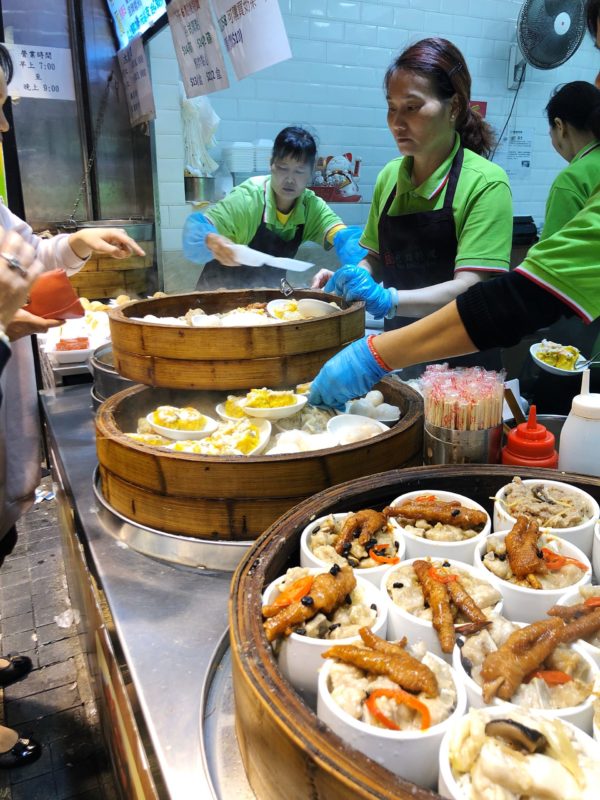
This guide will provide you with recommendations to explore Hong Kong’s local food scene and must-see destinations throughout Hong Kong Island, Kowloon & Lantau. As you’re navigating through Hong Kong’s hustle and bustle, I also provide recommendations to slow down the pace and take in the area’s natural beauty.
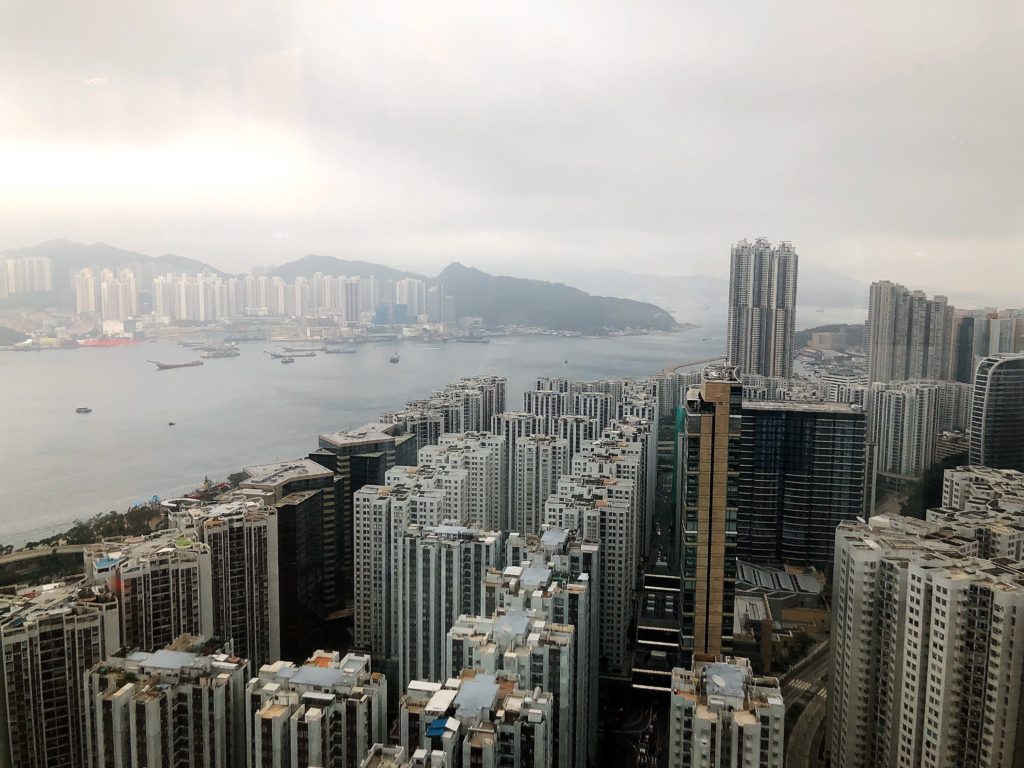
Guide to Visiting Hong Kong
To Eat:
Dim Sum at Lin Heung Tea House
Breakfast Set & Creamy Custard at Australia Dairy Co.
Steamed Milk Pudding Dessert at Yee Shun Milk Company
Japanese-inspired Drinks & Dinner at Yardbird
To See & Do:
Join a Hong Kong Free Walking Tour
Look out for #PrideInRainbow Street Art
Walk along Avenue of the Stars & Hong Kong’s Piers
Watch the Symphony of Lights
Visit The Monster Building Courteously
Escape the Hustle & Bustle:
Man Mo Temple
Chi Lin Nunnery & Nan Lian Garden
Lantau Island: Tian Tan Buddha & Tai O Fishing Village
Ohel Leah Synagogue
Tai Tam Reservoir Heritage Trail
Kowloon Park
Use ClassPass to get in Gym Time
A Few Highly Recommended Coffee Shops
Where to Stay:
Hotel Recommendations at Various Price Points

I came to Hong Kong to eat. It was delicious. I waited a decade to experience traditional dim sum in Hong Kong.
Lin Heung Tea House (蓮香樓)
A Hong Kong Dim Sum Must-Visit
It was worth it. My first stop after arriving in Hong Kong was Lin Heung Tea House (蓮香樓), the most famous traditional spot for Cantonese dim sum in Hong Kong. My flight landed at Hong Kong International Airport at 5:45 am. By 8:30 am I was in front of Lin Heung ready to start my Hong Kong adventures! Opened in 1926, Lin Heung has been serving up favorites such as steamed custard buns, Chinese sausage rolls & shumai in Hong Kong for almost 100 years! I highly recommend trying the steamed pork meatball with quail’s egg, which is harder to find outside of China.

Lin Heung Tea House History
Lin Heung moved to it’s current location in Hong Kong’s Central district in 1980, where is still is currently. Tip: If you want to get a seat, you’ve got to be aggressive. With about 50 tables, Lin Heung can fit up to 300 guests at a time. Seating is family-style, so find an open seat or two and jump in! There is no host, and it’s all self seating. When it gets busy you’ll see a lot of loitering and folks waiting for a spot to open up. Don’t be annoyed if you’re finishing up the meal and someone stands behind you. It’s standard practice. You can feel the hustle and bustle of Hong Kong mirrored in Lin Heung, and there is no better way to get a feel for the city than enjoying a meal here!
Ordering and Eating at Lin Heung
Once you do sit down, the waiter will give you a tally card to keep track of the dishes you order. One of the best parts of Lin Heung is that dim sum is still served on traditional trolley carts! As carts of buns, rolls and general delicousness roll by, diners flag down a server when they see an option that catches their eye. Depending on your order, the server will stamp your tally card, which acts as the bill on your way out. You can definitely enjoy dim sum on a solo trip, but it’s best with a small group so you can try a bunch of dishes!
Don’t forget the tea! I mean, Lin Heung is a tea house after all! You can choose from multiple tea varieties, including pu-er, jasmine and few others. When you sit down the server will bring over two tea cups for each person. At first I was really confused. When the couple sitting next me realized I had no clue what the do with the two cups, they showed me that the larger cup is for brewing the tea, and the smaller cup is for actually drinking. If you want a refill, just open the lid covering the larger cup, and a waiter will come by to pour some more hot water.

Want more dim sum? Check out Culture Trip’s round-up of The 10 Most Delicious Dim Sum Restaurants in Hong Kong! If you’re planning to visit Macau, I highly recommend a relaxing morning or early afternoon tea and dim sum lunch at Long Wah Tea House.

Australia Diary Company (澳洲牛奶公司)
Breakfast Set & Creamy Custard Delciousness
Considered to be a Hong Kong institution, Australia Dairy Company is known for their perfectly scrambled eggs and rich, creamy custard. 2020 marks Australia Dairy Company’s 50th anniversary!


Located in the heart of Kowloon’s Jordan neighborhood, don’t be surprised to find a line out the door. But don’t worry; it moves quickly. This cha chaan teng, or classic 1950’s / 60’s style Hong Kong cafe, is quick-in, quick-out. Meals are served up at a speedy pace that matches the vibe of Hong Kong. Go before noon to order a ‘Breakfast Set’, which comes with eggs (scrambled or fried), toast with butter, macaroni & ham in chicken soup and coffee or milk tea for HKD $36. Australia Dairy Company opens at 7:30 am, making for great breakfast spot if you’re starting early for a full day of sightseeing.

If you’re looking for a slower, more relaxed way to enjoy a custard, order a bowl to go. Hong Kong is full of lovely parks and promenades for you to sit and enjoy a snack!

Yee Shun Milk Company ( 義順牛奶公司 ) Steamed Milk Pudding Dessert
Yee Shun Milk Company is another Hong Kong must-try, best known for their ‘double-skin’ steamed milk pudding. This desert’s name comes from the thin layer of milk atop the sweet, creamy pudding below.
You can enjoy this dessert either hot or cold. In addition to the plain milk pudding you can try various flavors such as lotus seed, ginger and coffee milk pudding! My personal favorite was the red bean. I couldn’t get enough of the sweet red beans mixed into a bowl of warm, creamy pudding! Yum!

Yee Shun even uses milk sourced from their own buffalo farms in China! Yee Shun Milk Company has multiple locations in Hong Kong. I visited the Jordan store a few minute walk away from Australia Dairy Company.
Yardbird
Japanese-inspired Izakaya in Sheung Wan
Yardbird is a fantastic example of Hong Kong’s modern foodie scene, specializing in Japanese-inspired dishes and expertly crafted mixed drinks. Modeled after a modern izakaya, Yardbird is a hybrid bar/restaurant with large plates for dinner or smaller plates for sharing. The vibe is relaxed, yet fun. The food is delicious. And Yardbird serves up over 20 yakitori options! If you’re looking for a hip place for dinner in the Sheung Wan area, I definitely recommend Yardbird.
Note: Yardbird doesn’t open until 6 pm, so it’s not a lunch option.
Address: 154-158 Wing Lok Street (上環 154-158 永樂街)
View this post on InstagramA post shared by Yardbird (@yardbirdyakitori) on
Visiting Hong Kong is delicious. But, this small island Special Administrative Region has much more to offer than just mouth-watering dishes.

Hong Kong Free Tours Walking Tour
Walking tours are a great way for first-time visitors to get their bearings in Hong Kong. Whether you’re on a budget or not, I highly recommend joining a walking tour by Hong Kong Free Tours.

Hong Kong Free Tours is not your average tour company. Their guides are dedicated to introducing visitors to the social, political and economic issues that are top of mind to everyone living in Hong Kong today. I had the opportunity to join two tours, one of Hong Kong Island and one in Kowloon. Of course the guide showed our group key landmarks and notable sights. But, he also provided real insight into the local context and various perspectives on life in Hong Kong today. From the evolution of Hong Kong’s history as a British territory to current geopolitical tensions with Mainland China to housing inequality and an increasingly deteriorating housing situation for low-income and aging adults, Hong Kong Free Tours guides share a wealth of information. My guide even shared his own family’s personal story. This truly deepened my appreciation and understanding of what current life is like living in Hong Kong.
*Check Hong Kong Free Tour’s website for their most up-to-date tour schedule.
If you’re interested in a deeper understanding of Hong Kong’s unique political and cultural context, definitely join a for one of Hong Kong Free Tours offerings.

On the Kowloon Free Tour you will have the opportunity to learn about the context for the current housing shortage in Hong Kong, and how it is leading to a housing crisis especially for low-income families. The photo above is from an actual apartment in Kowloon that is rented out by Hong Kong Free Tours. Identical apartments in the building are home to full families. There is often little or no kitchen, which just an electric hot plate. Also, the building has only shared bathrooms.
The tours also introduce visitors to the popular destinations. Some of the destinations on the Kowloon tour include the Flower Market, Goldfish Market and Bird Market.

#PrideinRainbow Stairs in
Hong Kong's Wan Chai Neighborhood
The status of LGBTQ+ rights in Hong Kong have progressed considerably over the past few decades, and small acts of pride can be found when you’re least expecting them! But, Hong Kong still has a long way to go. Rights including same sex marriage are not recognized (as of May 2020). Yet, keep an eye out in Central Hong Kong and in the Wan Chai neighborhood for the #PrideInRainbow stairs or other statements of pride throughout the streets by @PrideInRainbow.

Just keep walking! My favorite moments when visiting Hong Kong were strolling along the piers and waterfront.

On your visit to Hong Kong, make sure to build time into your agenda to walk along the Avenue of the Stars in Tsim Tsa Tsui, located along the Victoria Harbor waterfront. The promenade opened in 2004 to honor the history of Hong Kong’s cinematic accomplishments through plaques, statues and installations. During the day it is a great place to watch the boats and water taxis traveling along the harbor. At night it is a fantastic location to watch Hong Kong’s Symphony of Lights display.
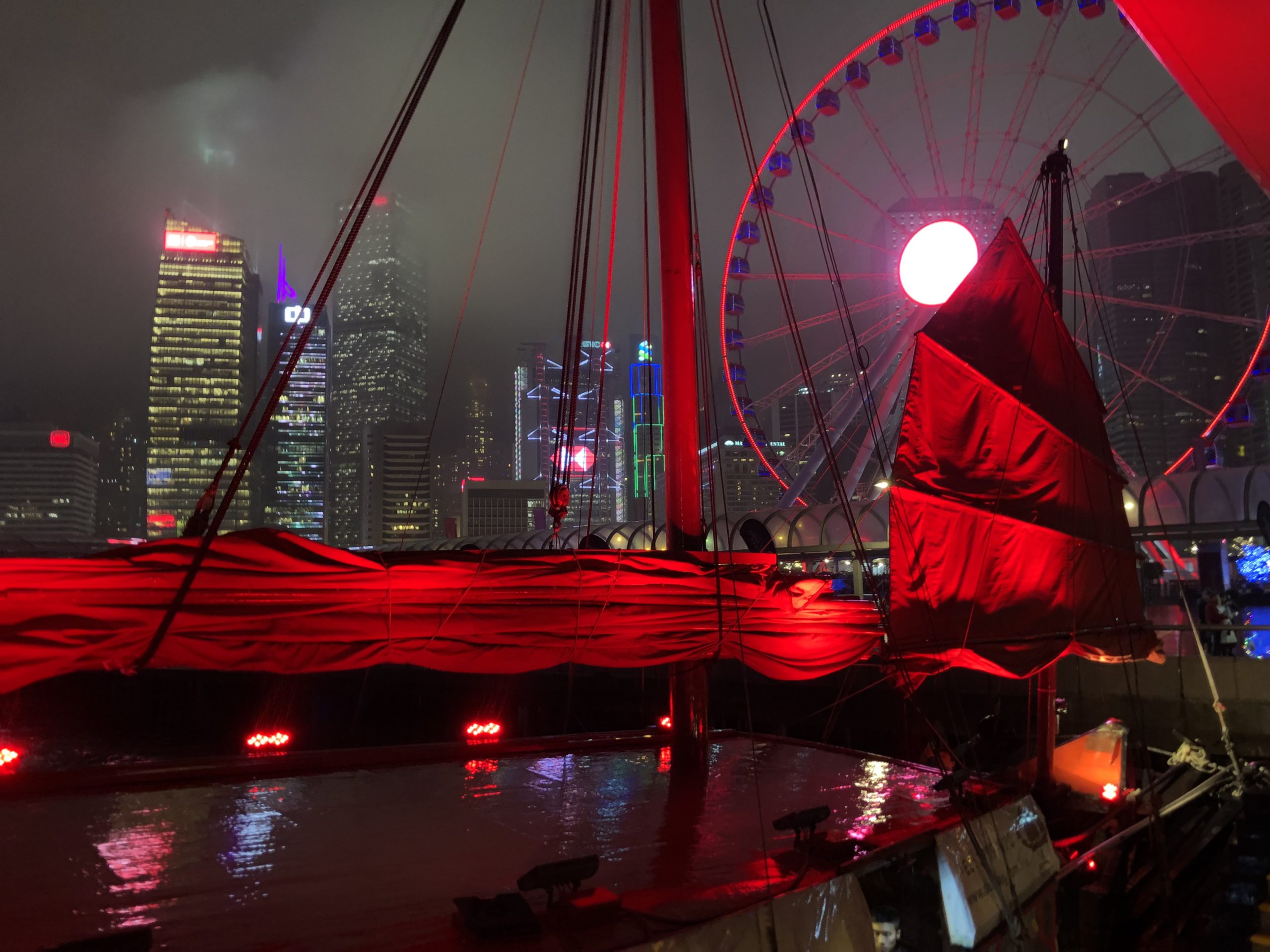
Walking along the Central Piers on the Hong Kong Island side is another great evening activity in Hong Kong!
Rain or shine, and especially on the weekend, you’ll probably see a variety of small karaoke stands set up with folks performing hits in multiple languages. Join the crowds to enjoy the entertainment!
Watch A Symphony of Lights from Victoria Peak
Hong Kong is home to one of the world’s largest light shows, “A Symphony of Lights”. Every night at 8 pm watch Victoria Bay turn into a multimedia disco party as strobe lights, LEDS and entire building facades light up the cityscape. There are many great spots to watch the show, but I highly recommend heading up to the Lugard Road Lookout spot on Victoria Peak. Seeing the harbor below illuminated into a rainbow of dancing lights and flashing colors is a experience that it is hard to believe happens every night in Hong Kong.
Tip for Getting to Victoria Peak
A common tourist attraction is to take the Peak Tram up to Victoria Peak. I’m sure this is really fun, but especially on weekend evenings the wait can be over two hours! I instead opted for the public bus on Route 15. I waited for 25 minutes and was passed by multiple buses that were completely full. I finally decided to share an Uber with a few other folks who were also waiting for the bus. It wasn’t the cheapest way to get to the top, but if you only have a limited time frame and don’t want to miss A Symphony of Lights show, Uber or a taxi may be worth it.

Take a Selfie at the Monster Building - Or, Maybe Don't
Heading to Quarry Bay for a selfie in front of ‘The Monster Building’ has become one of Hong Kong’s most Instagram-friendly spots, and it’s easy to see why. The Monster Building is actually an interesting architectural design combining 5 structures into a giant E-shaped building complex. The seemingly never-ending, multi-color apartments wrap around interior courtyards, seemingly making the perfect Insta-worthy background for visitors to Hong Kong.

To Consider Before Your Photoshoot
I encourage you to consider the context before setting out with your tripod and selfie-stick. The complex was actually built in the 1960’s in an effort to accommodate Hong Kong’s growing population of low-income residents. Today, the Monster Building is still home to many families and individuals, and the crowded residences are just one part of Hong Kong’s ongoing struggle with insufficient housing stock. Remember that the courtyards in The Monster Building are not public centers made for tourism and photographs. They are the limited amount of outdoor recreational space available to residents living in Hong Kong’s concrete jungle.
Sure, the photos maybe be great, but just remember you’re taking them in someone else’s backyard. The ground floor of most of the complex is retail. If you do visit, consider buying a snack from the shops or bakeries to contribute to the local economy in the neighborhood.
Guide to Visit Hong Kong:
Spots to Slow Down on Your Visit to Hong Kong
Hong Kong is buzzing with energy! But after a few days (or hours depending on your relationship with cities!) you may appreciate visiting these sites that will slow down the pace!
Man Mo Temple (文武庙)

Located just a 10 minute walk from Hong Kong Central, Man Mo Temple is quite a contrast from the business district it neighbors! Built in 1847, Man Mo Temple honors the God of Literature (Man) and the God of War (Mo). Historically, young students preparing for the civil service exam would come to Man Mo temple to worship and leave offerings in hopes of bettering their chances of success! If you visit Man Mo Temple temple today you will see a mixture of locals and tourists coming to worship or just take in the temple’s beauty.
Address: 124-126 Hollywood Rd, Sheung Wan, Hong Kong Island.

I highly recommend that everyone visit Man Mo before leaving Hong Kong. The first thing you notice upon entering the Temple is the ceiling covered in coils of incense. This creates an experience that consumes the senses in a way that words cannot describe. Just watching the incense brings about a feeling of calmness that is an appreciated respite from the exploring the Central neighborhood nearby. Man Mo Temple is recognized by the HK government as a Declared Monument. The Temple is generally open from 8 am to 6 pm, but hours vary on certain days and during festivals. Visit the Man Mo Temple website for more information.
Chi Lin Nunnery & Nan Lian Gardens
Chi Lin Nunnery is the epitome of structural dichotomy within Hong Kong’s urban landscape. Established in 1934 and renovated in 1990, Chi Lin Nunnery is a Buddhist temple complex boasting intricately crafted wooden architecture surrounded by calming lotus ponds and statues of the Buddha and various bodhisattvas.

Located next to the Nunnery is Nan Lian Garden, a public park designed after the style of the Tang Dynasty. In Chinese history, the Tang Dynasty was known as a time of artistic appreciation and development. If you look closely at the ornate wooden structures throughout Chi Lin Nunnery and Nan Lian Garden, you will notice the use of dougong, a unique and stylized design engineered to join the pillars and columns of a structure with the frame of the roof. Using the dougong technique, individual pieces are fit together in an intricate design using tension and balance that requires no additional glue or adhesive elements. Not only do Chi Lin’s duogong examples demonstrate structural genius, but also the delicate work carefully crafted by carpenters finding the intersection of between beauty and function. When I visited in 2019 there was actually an exhibit explaining the history and science behind the dougong technique, evening showing digital renderings of the construction of famous Chinese temples and structures that employ the technique.

Hong Kong's Urban Oasis
Standing in the middle of Nan Lian Garden is a surreal experience. Koi ponds, delicately landscaped trees, tranquil bridges and even a small waterfall provide a place for respite from the busy city. Yet, when you stop to look up for a moment you realize that this small oasis is completely surrounded by towering highrises and skyscrapers. A visit to Chi Lin Nunnery and Nan Lian Garden truly lets you see the evolution of urban development in Hong Kong over the past century. This is a perfect spot for capturing photos that show Hong Kong’s contrasting landscapes.

Nan Lian Garden also has a vegetarian restaurant and tea house. I tried the vegetable dumplings, and they were just okay. But, I highly recommend building an hour or two to sit and enjoy tea and a snack. The tea selection is nice, and the staff can show you how to have a small, yet traditional tea ceremony. Note that there is a minimum per person spend, so this is not the place to go for a quick snack or travels on a tight food budget. Take time to enjoy the calm surroundings and recharge before the next stop on your agenda.

Chi Lin Nunnery and Nan Lian Garden are located in Hong Kong’s Diamond Hill neighborhood, on the north side of Kowloon. You can take MTR to the Diamond Hill Station (Exit C2) on the Green Line. From there it is just a 5 minute walk. If you have the time, I recommend taking the bus. It took me about an hour by bus from Tsim Tsa Tsiu to Diamond Hill. I rode on the top level of a double decker bus and was able to see more of the city on the ride.
Lantau Island: Giant Buddha & Tai O Fishing Village
Hong Kong’s Lantau Island is home to the world’s largest outdoor bronze seated Buddha! Lantau is Hong Kong’s largest island, and home to the Tian Tan Buddha, Po Lin Monastery, Tai O Fishing Village, Disneyland and more. On my visit to Hong Kong I only spent one day on Lantau. I recommend taking more time to explore the local villages, beaches and hiking options if you have the time.
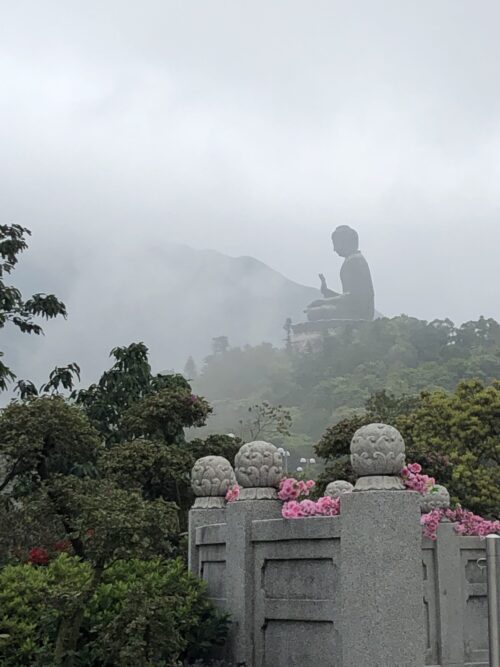
To get to Lantau Island and visit the Buddha, you can take the Ngong Ping 360 cable car from the Tung Chung MTR station. Book your cable car tickets in advance on Klook for a cheaper fare! You can choose from 2 cabin options: the standard cable car or the Crystal Cabin, which has a clear bottom and roof for the best view. I chose the Crystal Cabin upgrade, which was pretty cool to be able to look straight down as you ride over Tung Chung Bay and the hills Lantau North Country Park below. It’s a 25 minute ride up to Ngong Ping Village. If you’re traveling on a budget, an easy way to save a little is to opt for the standard car or you can also take public transit. Check out The Whole World is a Playground’s post for more specific directions on how to navigate public transit to the Big Buddha and Tai O Fishing Village.
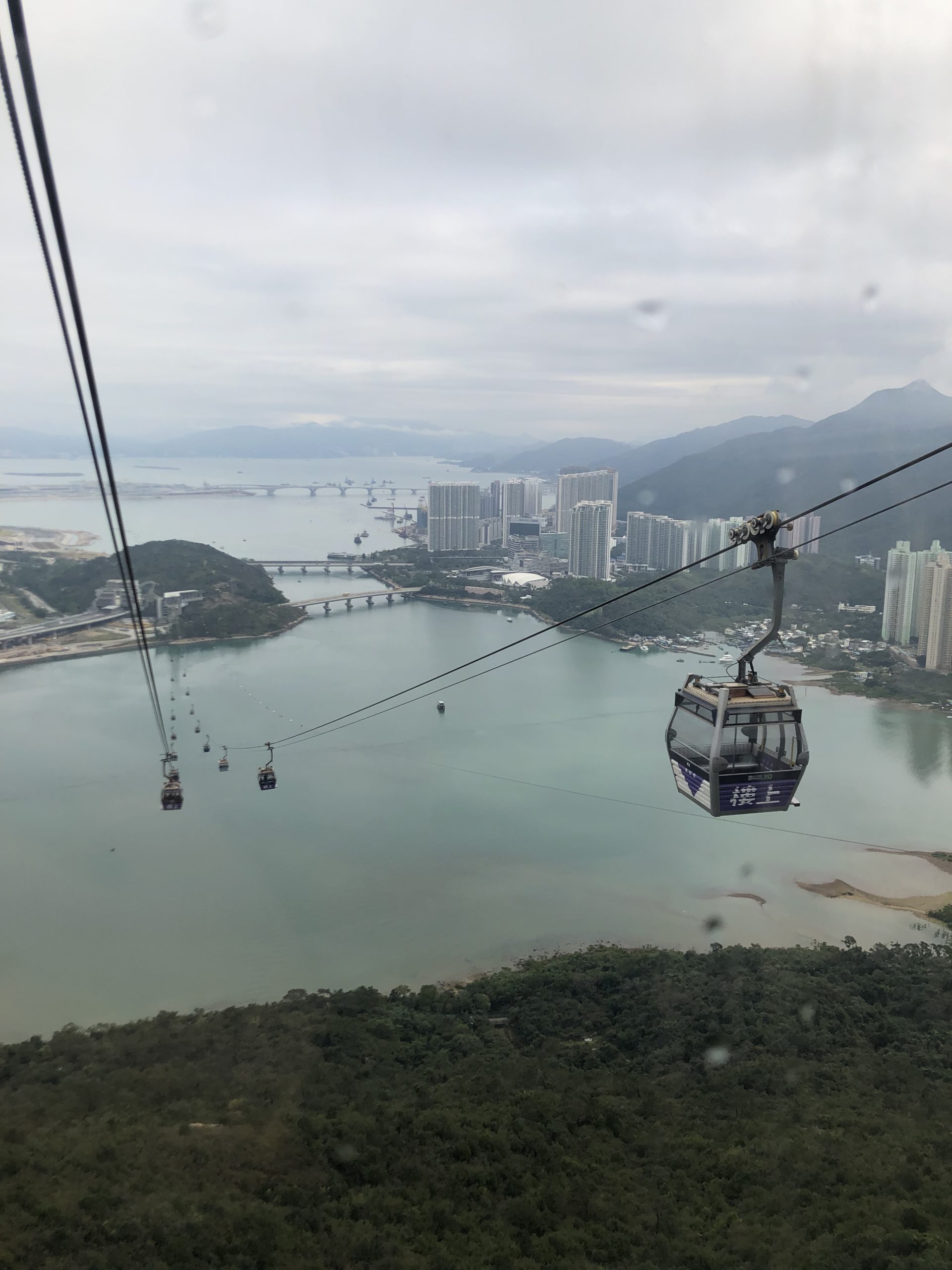
The cable car or bus will bring you to the Ngong Ping Village. There you can buy snacks, souvenirs and walk up to visit the Buddha. Hong Kong’s Tian Tan Buddha is the largest seated bronze buddha in the world, standing over 75 feet tall! Wear comfortable shoes because there are 268 steps up to the Buddha’s platform. Unveiled in 1993, the Big Buddha is relatively new addition to Hong Kong’s skyline.
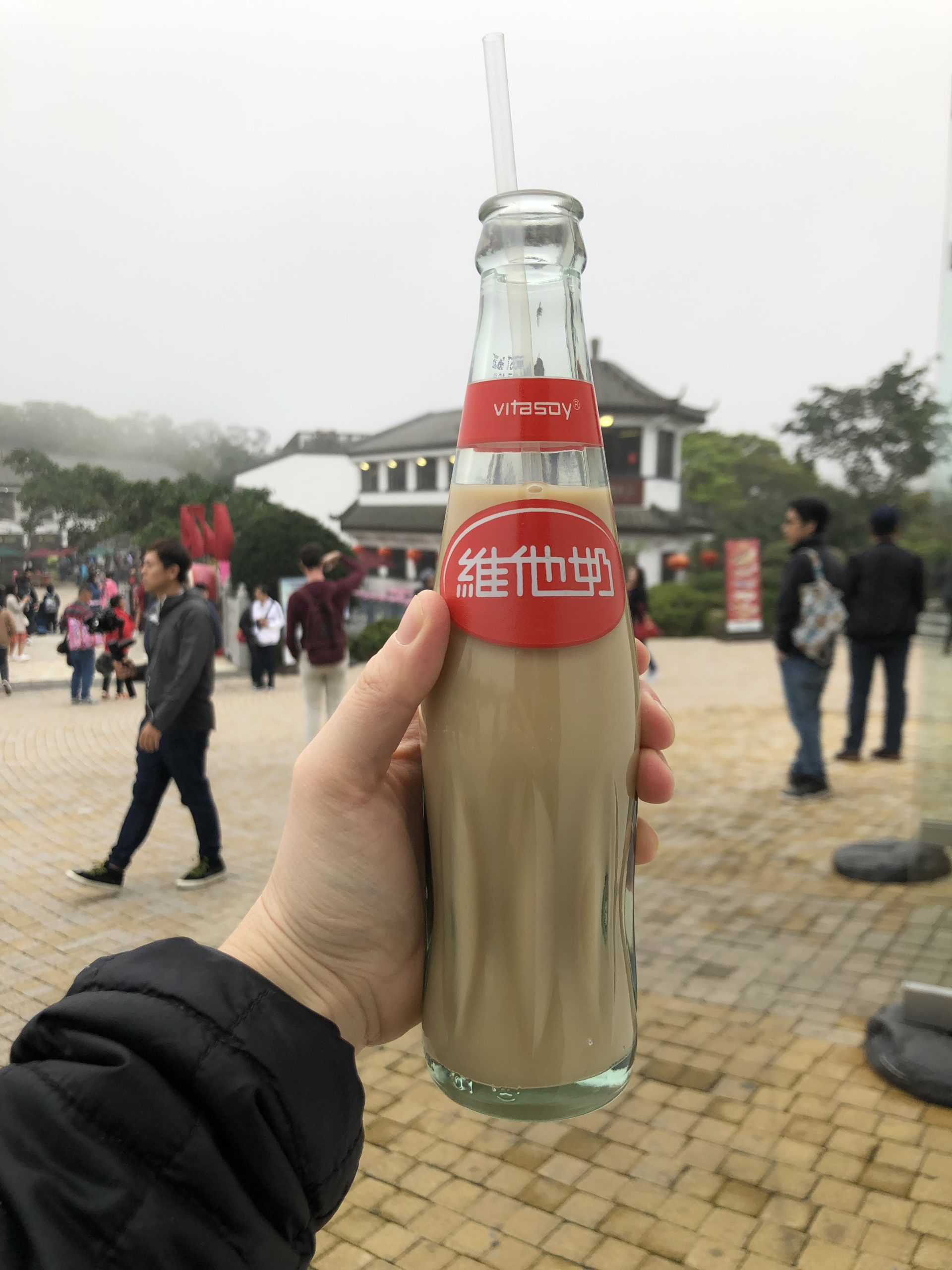
You can either visit Lantau’s Big Buddha through an all-in-one package combining the cable car, tour, and guide to Tai O fishing village or plan a self-guided trip. As a first time and solo visitor to Hong Kong, I opted for the guided tour. The tour was cheapest through Klook and could skip the line for the cable car. Tip: If you take the tour, remember that the cable car is a 25 minute ride, and you should plan to arrive at the Tung Chung MTR station at least 45 minutes before your tour starts. That way will you have plenty of time if there is a long queue.
Joining a tour was easy way to visit Lantau for first-time visitors to Hong Kong, but if you want more time or flexibility, you can definitely visit on your own.
Tai O Fishing Village

One the western end of Lantau Island you’ll find Tai O Village, a historic fishing village. Over the past 300 years Tai O has played different roles in the history of Hong Kong. Tai O was a strategic military area for Portuguese troops in the 17th century and entry point for covert goods and illegal immigration from Mainland China during the Chinese Civil War (1927-1949). It also has a history of salt production during the mid 1900’s. Over the past few decades Tai O’s economy has suffered, with many residents living on a very low income.

Currently, tourism is the main draw and an important source of income to the local community living in Tai O. Younger folks are leaving the area as employment options are limited, especially compared with other areas in Hong Kong.
Visitors from Hong Kong and around the world make their way to Tai O to see the traditional stilt houses, enjoy fishballs and cruise around the bay with the hope of spotting the local pink dolphins! There are fun snacks to try in Tai O Village, including stalls selling fish balls. I recommend trying curry flavored ones!

Looking for an opportunity to give back while visiting Hong Kong?
Sign up with Hands on Hong Kong to participate in volunteer events during your visit! If you’ll be visiting Lantau Island, consider signing up to lend a hand to the beach clean-up efforts at Sam Pak Wan, near Discovery Cove.
Ohel Leah Synagogue
If you’re interested in Jewish culture and history, plan a visit to the Ohel Leah Synagogue in Hong Kong’s Mid-Levels neighborhood. I highly recommend to contact the synagogue or the Jewish Historical Society of Hong Kong BEFORE visiting to make sure you can enter. I did not book in advance, and due to heightened security I was almost not allowed to enter, as the synagogue is not generally open to the public. If you are interested, it is worth the effort of trying to schedule a visit.
By the end of the 19th century Hong Kong was home to a prospering Jewish community, mostly of Sephardic ancestry. Under British rule, free-trade policies drew merchants from around the world, including Jewish traders from Iraq and India. In 1902 Ohel Leah Synagogue opened, made possibly by the generosity of the Sassoon family who donated the land and funded the initial construction. Jewish immigration to Hong Kong increased throughout the early 1900s as European Jewish communities were fleeing persecution and growing anti-Semitism. During WW II Japanese forces occupied the area, and members of the Jewish community faced internment in POW camps, and it was a dark time in Hong Kong.

The historic Ohel Leah Synagogue still stands, and in 1997 a restoration project began to bring the building back to it’s original grandeur. Today over 200 families are still members of Ohel Leah. If you make it for a visit, the synagogue is a bit tricky to find, and you will have to go through strict security. Once inside the restored sanctuary space is beautiful, and there is a small exhibit space with panels sharing the history of Hong Hong’s Jewish community and Ohel Leah.
Don't Miss Getting Out to Explore Nature
on Your Visit to Hong Kong
Hike the Tai Tam Reservoirs Heritage Trail
Hong Kong is a booming global urban center for economics and trade, but it is also home to hikes, nature walks and even a GeoPark! You can experience much of Hong Kong’s natural beauty conveniently right off metro lines and public transit. Dragon’s Back is the most well known trail, offering beautiful views of Hong Kong island from Shek O point. But, don’t miss out on other fantastic trails and scenic views around the area.

If you’re visiting or staying near the Quarry Bay / Tai Koo area, I recommend walking along the Tai Tam Reservoirs Heritage Trail.
Staring from either Quarry Bay or Tai Koo MTR stops, you will walk about 10 minutes along Kings Road until turning onto Mount Parker Road to begin the hike. The ground here is well paved, but with a steep incline that you will bring you high enough for picturesque vistas, you will definitely get a workout! You will continue along Mount Parker Road until you enter into the Tai Tam Country Park. The trail is about 5 to 6 kilometers (3.5 miles), and will take about 2 hours to complete, building in a little rest time.

History of Tai Tam Reservoirs
The Tai Tam Reservoirs were built between 1883 and 1917, key to the urban development and increasing population’s need for potable water in Hong Kong at the turn of the 20th century. Along the walk you’ll find historic remnants of reservoir’s history, including when it doubled as a military site during WWII. To learn more about the path, read Discover Hong Kong’s guide here.
Along the way you may also notice signs warning you about wild pigs in the area. We didn’t happen to see any, but if one crosses your path make sure to ignore it and not engage. You can also explore many other hiking trails throughout Hong Kong here.
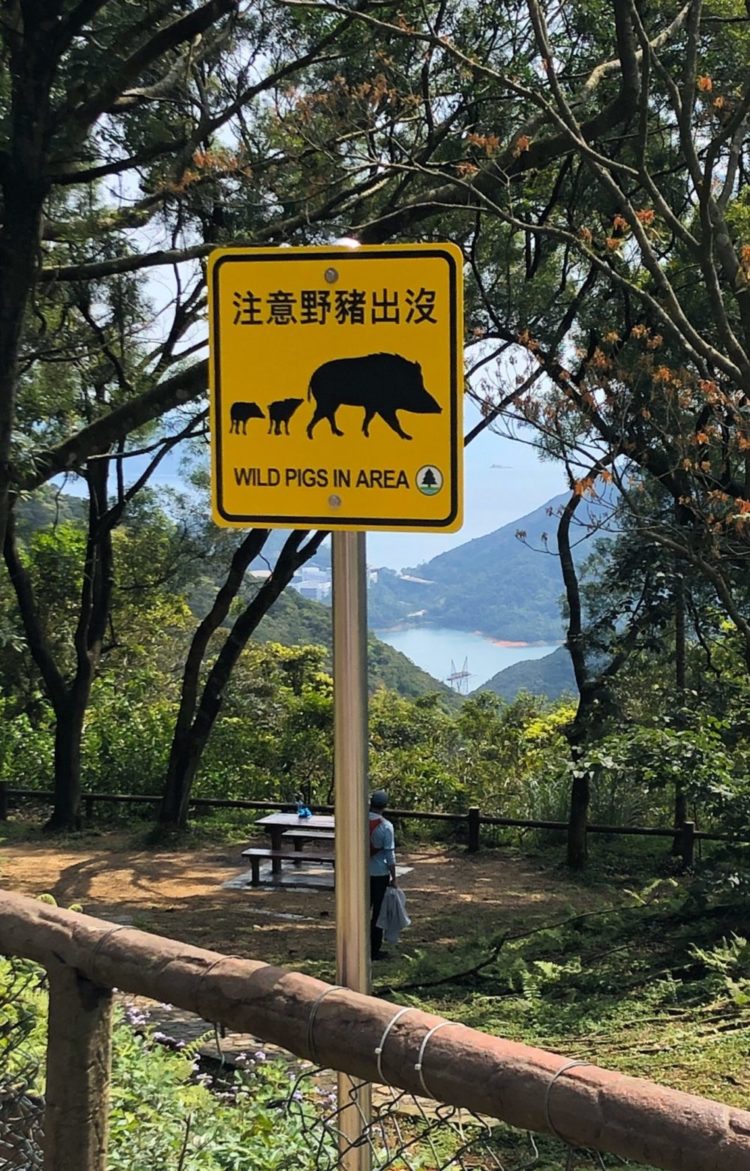
Kowloon Park
Located along Nathan Rd in Tsim Tsa Tsui, Kowloon Park is the perfect spot to take a little break. Head to Kowloon Park in the morning and you will see locals doing Tai Chi and exercises to get the body waking up. Kowloon Park has a variety of indoor and outdoor facilities, including a sculpture garden, an aviary, children’s play areas, sports fields, and even flamingos! If you’re staying in Tsim Tsa Tsui, Kowloon Park is a peaceful place to start your morning or take an afternoon break.
If you’ll be visiting Hong Kong on a Sunday, head to Kung Fu Corner of Kowloon Park’s Sculpture Walk between 2:30 pm and 4:30 pm to see free Kung Fu and Lion Dance demonstrations!

Hoping to Get Some Gym Time in
While Visiting Hong Kong?
If you are a ClassPass subscriber, there are plenty of workout options in Hong Kong!
With participating studios throughout Hong Kong Island and Kowloon, take advantage of strength training, dance or yoga during your visit! There are also plenty of classes offered in English especially in the Wan Chai area. It can be difficult to fit in time for gym classes while traveling, but I highly recommend making time for at least one yoga class. It is a great way to relax and stretch after a lot of walking and you get the chance to see a different side of everyday life. I recommend One Yoga, where I joined a Vinyasa Flow class during my stay in Hong Kong.
Coffee Break!
Best Cafes in Hong Kong
Coffee aficianados, Hong Kong will not let you down! Over the past decade, Hong Kong’s artisanal coffee scene has exploded, along with the rise of competitive barista training and increased scrutiny of responsibly sourced beans.
My top recommendation is Coffee Academics!

Opened in 2012, Coffee Academics has grown to be an internationally recognized purveyor of high-quality coffee. Coffee Academics has multiple locations throughout Hong Kong (and their own roastery!). If you’re into single origin coffees, expertly prepared espresso drinks or just looking for a damn good cup of coffee, I highly recommend Coffee Academics.
Honestly, the best latte I have ever had in my life was from Coffee Academics! Only caveat is you can expect to pay at least $5.00 for even a small latte or cappuccino. But, in my opinion, it’s totally worth it.

Brew Bros in Sheung Wan & NOC Coffee in Central are two more great coffee options at the heart of Hong Kong! Seating is pretty limited at Brew Bros, but the coffee is great! NOC Coffee on Gough St. in Central has a bit more seating, with a small additional area upstairs.
Where to Stay in Hong Kong
There are plenty of great hotel options in Hong Kong for a range of prices. If you’re looking for a centrally-located hotel that is decent and not a hostel, plan to spend at least $40 a night. You can definitely find cheaper options, but rooms will be very small and the hotel building may be dingier. I found the best prices on Agoda.com.
Homy Hotel Central in Sheung Wan: conveniently located next to the Sheung Wan MTR station, Homy Hotel Central is small, yet clean and is in a fantastic location. The staff were lovely, and a single room with a private bathroom cost me about $40/night. (105-107 Wing Lok St.)
Hotel Hart in Tsim Tsa Tsui: a 2-min walk from the Tsim Tsa Tsui MTR station, Hotel Hart is classy, clean and chic hotel located in close proximity to many of Kowloon’s major tourist sites. A single room at Hotel Hart was a bit pricier at about $140 / night. (But, I booked the day before, so this price is probably not indicative of an advanced booking.) This is a perfect hotel for mid-range travelers who would rather stay in a smaller hotel than at a big chain.

Are you traveling to Tai Koo for business? If so, I highly recommend the East Hotel. This 4-star hotel offers high-quality accommodations, especially for visitors coming to the Tai Koo area for work. East Hotel has super-friendly staff and large rooms lined with windows. Honestly, I am not sure about price since I booked through my company’s travel site. For a budget / mid-range traveler like me, staying at East Hotel was really a treat!
Did you enjoy this post or have any other Hong Kong suggestions for folks who are planning a visit to Hong Kong? Let us know in the comments!



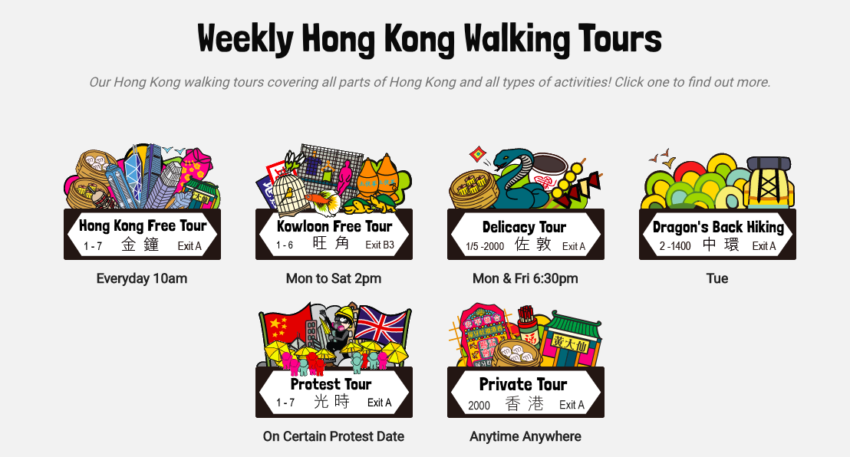



Hong Kong is such an interesting destination to visit, at least it’s to my opinion! I’d love to visit this part of Asia whenever I go back. I’m collecting travel guides so definitely saving this one for the future. 🙂
Thanks, Melissa! I hope you make it there! And share photos when you do 🙂
Wow. Very detailed and well done! I plan to cycle Hong Kong soon so thank you for all the places to eat and do!
Thanks, Monica! I hope you make it there, and have a great time!
I love how detailed you made this post! And how much attention you put into for tips on how to stay socially conscious. We often overlook that and just go to countries for our own benefits, not being courteous of the people hosting us. I also enjoyed the bits of history you gave on Hong Kong too! Hong Kong reminds me so much of Singapore when I lived there. The food is DEFINITELY what I’d go there for too!
Thanks, Lauren! I appreciate your comments. The food is sooo good, and I am planning a trip to Singapore for the same reason. 🙂 Was hoping to be there about this time, but we’ll see based on travel regulations. ::crossing our fingers:: Any top recommendations for when I can finally visit?
Hong Kong looks like such a cool city! The food scene looks incredible and I would love to visit!